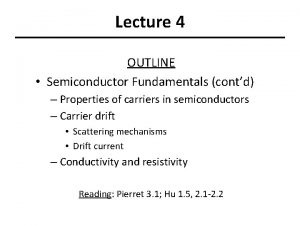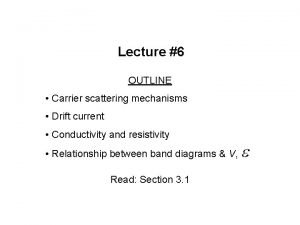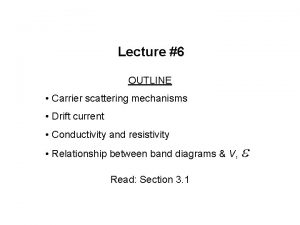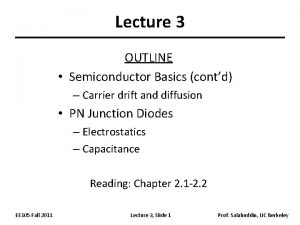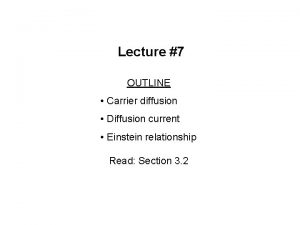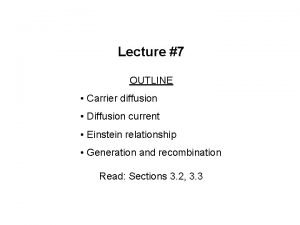Lecture 6 OUTLINE Carrier scattering mechanisms Drift current


















- Slides: 18

Lecture #6 OUTLINE • Carrier scattering mechanisms • Drift current • Conductivity and resistivity • Relationship between band diagrams & V, Read: Section 3. 1 e

Mechanisms of Carrier Scattering Dominant scattering mechanisms: 1. Phonon scattering (lattice scattering) 2. Impurity (dopant) ion scattering Phonon scattering mobility decreases when T increases: = q / m 2 Spring 2007 EE 130 Lecture 6, Slide 2

Impurity Ion Scattering Boron Ion - _ Electron - Electron + Arsenic Ion There is less change in the electron’s direction of travel if the electron zips by the ion at a higher speed. 3 Spring 2007 EE 130 Lecture 6, Slide 3

Matthiessen's Rule • The probability that a carrier will be scattered by mechanism i within a time period dt is where i is the mean time between scattering events due to mechanism i The probability that a carrier will be scattered within a time period dt is 4 Spring 2007 EE 130 Lecture 6, Slide 4

Mobility Dependence on Doping Total Doping Concentration NA + ND (cm-3) 5 Spring 2007 EE 130 Lecture 6, Slide 5

Temperature Effect on Mobility 6 Spring 2007 EE 130 Lecture 6, Slide 6

Drift Current vd t A = volume from which all holes cross plane in time t p vd t A = # of holes crossing plane in time t q p vd t A = charge crossing plane in time t q p vd A = charge crossing plane per unit time = hole current Hole current per unit area J = q p vd 7 Spring 2007 EE 130 Lecture 6, Slide 7

Conductivity and Resistivity Jn, drift = –qnvdn = qn ne Jp, drift = qpvdn = qp pe Jdrift = Jn, drift + Jp, drift = e =(qn n+qp p)e Conductivity of a semiconductor is qn n + qp p Resistivity 1 / (Unit: ohm-cm) 8 Spring 2007 EE 130 Lecture 6, Slide 8

Resistivity Dependence on Doping For n-type material: p-type For p-type material: n-type Note: This plot does not apply for compensated material! 9 Spring 2007 EE 130 Lecture 6, Slide 9

Electrical Resistance V I + _ W t homogeneously doped sample L Resistance (Unit: ohms) where is the resistivity 10 Spring 2007 EE 130 Lecture 6, Slide 10

Example Consider a Si sample doped with 1016/cm 3 Boron. What is its resistivity? Answer: NA = 1016/cm 3 , ND = 0 (NA >> ND p-type) p 1016/cm 3 and n 104/cm 3 11 Spring 2007 EE 130 Lecture 6, Slide 11

Example: Dopant Compensation Consider the same Si sample, doped additionally with 1017/cm 3 Arsenic. What is its resistivity? Answer: NA = 1016/cm 3, ND = 1017/cm 3 (ND>>NA n-type) n 9 x 1016/cm 3 and p 1. 1 x 103/cm 3 12 Spring 2007 EE 130 Lecture 6, Slide 12

Example: Temperature Dependence of r Consider a Si sample doped with 1017 cm-3 As. How will its resistivity change when the temperature is increased from T=300 K to T=400 K? Solution: The temperature dependent factor in (and therefore ) is n. From the mobility vs. temperature curve for 1017 cm-3, we find that n decreases from 770 at 300 K to 400 at 400 K. As a result, increases by 13 Spring 2007 EE 130 Lecture 6, Slide 13

electron kinetic energy hole kinetic energy Ec Ev increasing hole energy increasing electron energy Potential vs. Kinetic Energy Ec represents the electron potential energy: 14 Spring 2007 EE 130 Lecture 6, Slide 14

Electrostatic Potential, V N- • The potential energy of a particle with charge -q is related to the electrostatic potential V(x): 15 Spring 2007 EE 130 Lecture 6, Slide 15

Electric Field, e N- • Variation of Ec with position is called “band bending. ” 16 Spring 2007 EE 130 Lecture 6, Slide 16

Carrier Drift (Band Diagram Visualization) Ec Ev 17 Spring 2007 EE 130 Lecture 6, Slide 17

Summary • Carrier mobility varies with doping – decreases w/ increasing total concentration of ionized dopants • Carrier mobility varies with temperature – decreases w/ increasing T if lattice scattering is dominant – decreases w/ decreasing T if impurity scattering is dominant • The conductivity of a semiconductor is dependent on the carrier concentrations and mobilities = qn n + qp p • Ec represents the electron potential energy Variation in Ec(x) variation in electric potential V Electric field • E - Ec represents the electron kinetic energy Spring 2007 EE 130 Lecture 6, Slide 18 18
 Semiconductor
Semiconductor Drift current and diffusion current in semiconductor
Drift current and diffusion current in semiconductor Drift current and diffusion current
Drift current and diffusion current Diffusion current density
Diffusion current density Longshore drift vs longshore current
Longshore drift vs longshore current Current density
Current density Drift current density unit
Drift current density unit Drift current in semiconductor
Drift current in semiconductor 01:640:244 lecture notes - lecture 15: plat, idah, farad
01:640:244 lecture notes - lecture 15: plat, idah, farad Lecture outline example
Lecture outline example Lecture outline example
Lecture outline example Lecture outline example
Lecture outline example Lecture outline meaning
Lecture outline meaning A balanced delta connected load having an impedance 20-j15
A balanced delta connected load having an impedance 20-j15 Power formula three phase
Power formula three phase Ac theory 3 lesson 4
Ac theory 3 lesson 4 The constant current area of a fet lies between
The constant current area of a fet lies between Wye and delta connections
Wye and delta connections Slideplayer
Slideplayer






